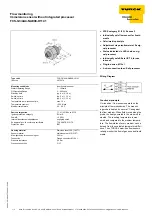
2017-05-12
User Manual
SONO-MIX MINI Version 2_7
Page 23
3.2.2. Calculation for a linear 1-point calibration curve
In practice during commissioning of a SONO probe in process, it could be happen that the measured
material above the probe is only available with a single moisture value. So a 2-point calibration could
not be carried out.
The procedure described below is not as precisely like a 2-point calibration, but it could be a
compromise to achieve an acceptable result for a usable calibration curve.
Below you will find the basic steps which are necessary:
1. Measure the radar travel time
Tp
in the running process while the material lies or flows above the
SONO probe´s surface.
Tp
can be measured with help of the module
SM-USB
or with the display
module
SONO-VIEW
.
2. Determine the reference moisture
M in %
of the measured material which lies above the SONO
probe. Unless the material moisture is already known, the reference moisture can be determined
with an infrared- or microwave oven in the laboratory.
3. Determine the bulk
density D
of the material in kg per dm
3
. Unless the bulk density is already
known this can be done by weighing of exactly 1 liter volume of the material.
4. Download the Excel-Sheet
„SONO 1-Point LinearCalibration_Calculation“
from IMKO´s
Homepage under „Support Software“. Enter the three determined parameters
Tp
(Radar travel
time),
M
(Moisture) und
D
(bulk density) into the Excel-Sheet. As result you get the two
calibration curve coefficients m0 and m1.
5. Enter, set and s
ave both parameters m0 and m1 with help of the software „SONO-CONFIG“ in the
menu „
Calibration
“ in the window „
Material Property Calibration
“ in the selected calibration curve.
The three parameters
Tp, M
and
D
can be also entered without a PC with the module SONO-VIEW
(see manual SONO-VIEW).
3.2.3. Calculation for a non-linear calibration curve
SONO probes can work also with non-linear calibration curves with polynomials up to 5th grade.
For a non-
linear calibration it is necessary to calibrate with 4…8 different calibration points with
different Tp values and the related moisture values in %. To calculate nonlinear coefficients for
polynomials up to 5th grade, an EXCEL software tool from IMKO can be used.
1. Download the Excel-Sheet
„SONO_NonlinearCalibration_Calculation“
from IMKO´s
Homepage under „Support Software“.
2. Enter the TP-values with the respective reference moisture values into the Excel-Sheet.
3. Read out the parameters m0 to m5 from the Excel-Sheet.
4. Enter, set and save the parameters m0 to m5 in the selected calibration curve with help of the
software „SONO-CONFIG“ in the menu „
Calibration
“ under the window „
Material Property
Calibration
“.
















































